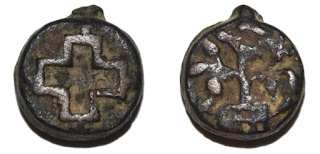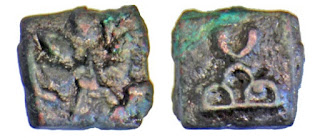The Shunga or Sunga Empire was an ancient Indian Brahmin dynasty from Magadha that controlled areas of the central and eastern Indian subcontinent from around 184 to 75 BCE, about 50 years after Ashoka's death.
Shunga coin 150 BCE
Emperor Brihadratha Maurya, the last ruler of the Maurya Empire, was assassinated by his commander-in-chief, Pushyamitra Shunga. Pushyamitra, then ascended the throne and became the ruler of Magdha and neighbouring territories. Its capital was Pataliputra, but later emperors such as Bhagabhadra also held court at Besnagar (modern Vidisha) in eastern Malwa.
The Shunga controlled Ayodhya, as is inscribed on the ''Dhanadeva-Ayodhya inscription''. Dhanadeva, is claimed to be the sixth descendant of Pushyamitra Shunga. The empire extended upto present day Sialkot in Punjab and upto the Narmada River in the south.
Pushyamitra ruled for 36 years and was succeeded by his son Agnimitra.
Among the 10 Shunga Emperors that ruled from 185 to 73 BCE, a few like Pushyamitra are known to have revived the supremacy of the Brahmanical religion and reestablished Yajnas that had been prohibited by Ashoka and the Mauryan Empire. He is frequently linked with the persecution of Buddhists and a resurgence of Brahmanism.
He may also have been the reason for the original Sanchi stupa that was vandalized sometimes in the 2nd century BCE. Though majority if the Shunga emperors were seen as amenable to Buddhism, as they have contributed to the building of the Stupa at Bharhut and improving the Sanchi Stupa, by covering the brick with stone. Further support for Buddhism by kings Brahamamitra and Indragnimitra is recorded at the Mahabodhi Temple in Bodh Gaya.
War and conflict characterized the Shunga period. They are known to have been in battle with the Kalingas, Satavahanas, the Indo-Greeks and possibly the Panchalas.
Mathura, however, was under control of the Indo-Greeks during the 1st century BCE, as inscribed on the ''Yavanarajya inscription'' also called the '' Maghera inscription'', discovered in Mathura.
Art, education, philosophy and other learning flowered during this period. Most notably, Patanjali's Yoga Sutras and Mahabhashya were rejuvenated during this period, and devotion that anyone could practice.
The richness of India's spiritual tradition, from which the whole world has gained insight, owes much to this period.
Artistry on the subcontinent progressed with the rise of the Mathura school, which was considered the indigenous counterpart to the Hellenistic Gandhara school (Greco-Buddhist art).
The script used by the Shunga was a variant of the Brahmi and was used to write the Sanskrit language. The script is thought to be an intermediary between the Maurya and the Kalinga Brahmi scripts.
After the death of Agnimitra, the second king of the dynasty, the empire began to disintegrate. Inscriptions and coins indicate that much of northern and central India consisted of small kingdoms and city-states that were independent of any Shunga hegemony. The last king of Sungas, Devabhuti was assassinated by his minister Vasudeva Kanva, who the established Kanva dynasty



















No comments:
Post a Comment
Any inputs or feedback is welcome!